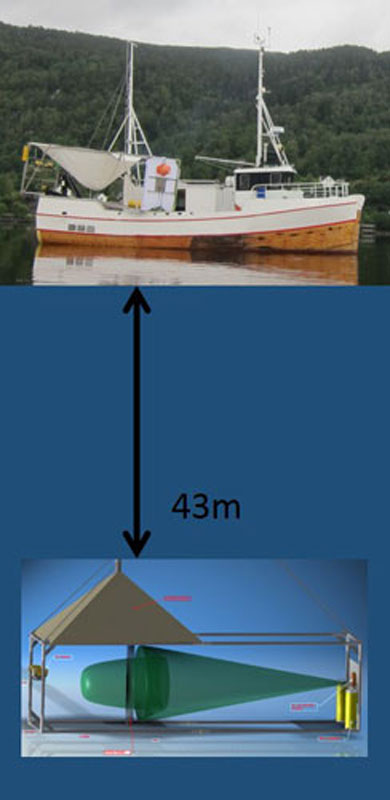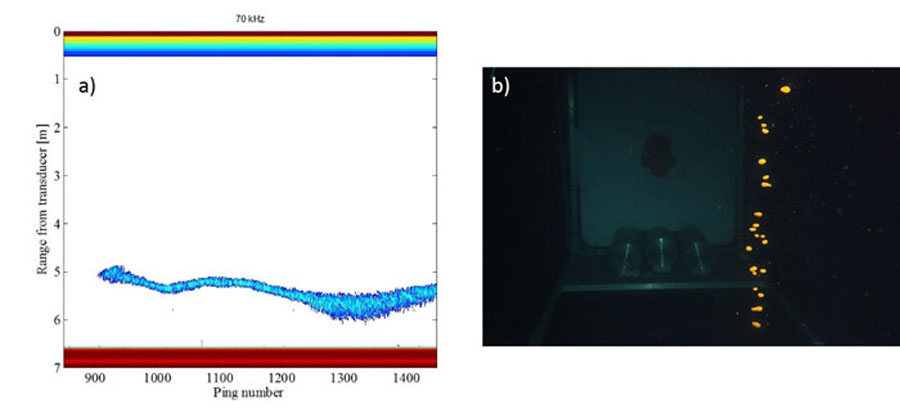Active Acoustic Detection of Subsea Oil and Gas Leaks; Model Prediction and Measurements
Geir Pedersen - Geir.Pedersen@cmr.no
Rune Hauge
Christian Michelsen Research (CMR)
P.O. Box 6031
NO-5892 Bergen
Norway
Rokas Kubilius
Institute of Marine Research (IMR)
Postboks 1870 Nordnes
5817 Bergen
Rokas Kubilius
Terje Torkelsen
Marine Ecosystem Technologies (METAS)
Nedre Åstveit 12
5106 Øvre Ervik
Bergen, Norway
Popular Version of Paper 3aUWb15
Presented Wednesday morning, May 7, 2014
167th ASA Meeting, Providence
---------------------------------
Subsea leak detection is an important and prioritized area of research and development. Safe subsea production of oil and gas requires rapid detection of accidental releases, eliminating potential harm to humans and the environment.
A range of technologies for underwater leak detection exists and new ones are under development, several of which are based on acoustics, either passive or active. In this context, passive acoustics means listening for noise generated by leaks. Using active acoustics means that sound waves are generated and sent through the ocean, and if there is a leak, the backscattering (or echo) from the leak is detected. This backscattering is due to the different acoustic properties of seawater and gas or oil.
For the measurements in this study, scientific echosounders designed for fisheries research applications were used (Kongsberg Maritime, Simrad EK60). An echosounder is an active acoustic instrument that sends sound waves through the ocean. Scientific echosounders are sensitive instruments able to detect organisms in the water column ranging in size from plankton to large mammals.
The objective of this study was to compare calculations using existing models for acoustic backscattering with measurements, and to identify whether active acoustics is a suitable approach for long-range detection of leaks. The overall goal is the development of a new leak detection system.
At a sheltered location in a fjord near Bergen, Norway, small quantities of vegetable oil and different gases were released and measured using a custom build experiment frame by Marine Ecosystem Technologies (Figure 1.). Echosounders were mounted in the frame sending out ultrasound pulses at four different frequencies (70, 120, 200, and 333 kHz). A stereo camera synchronized with the echosounders recorded images of the releases of gas and oil. From the images the sizes of individual bubbles and droplets, and the physical dimensions of the plumes were measured. The measurements were compared with theoretical predictions of backscattering from leaks with the same properties as the ones measured.

Figure 1. The experiment frame is shown at the bottom of the figure. On the right side of the frame the echosounder electronics are seen (yellow cylindrical containers) as are the vibrating part of the echosounder, the transducers (orange circles). The green “searchlight” from the transducers indicates the acoustic beam. The stereo cameras are seen on the left end of the frame. The cameras field of view and the echo sounders acoustic beams overlap where the leak rises from the nozzles mounted at the bottom of the frame. A funnel for collecting the released oil was installed at the top of the frame.
Figures 2-3 show two examples of the many leaks generated and measured. In Figure 2a an echogram shows the acoustic signal from a methane gas (CH4) leak released at a rate of 1 l/min from a 3.8 mm circular nozzle. The echogram shows the backscattering by the methane bubbles rising through the water column and into the beam of the echosounder. The vertical axis of the echogram indicates range from the echosounder, which is located at 0 m in the echogram. The release is clearly visible at five meters from the echo sounder, starting at about ping number 150 (in red and yellow indicating a strong reflection). The strong horizontal line at the bottom of the figure is due to scattering from the far end of the experiment frame. An image from the stereo camera is shown in Figure 2b, where the methane bubbles rise from the nozzle located at the bottom of the measurement frame.

Figure 2. a) Echogram showing a methane leak at a distance of five meters from the echo sounder; b) Image from one of the stereo cameras showing the methane bubbles rising from the nozzle.
Figures 3a and b show an oil leak released at a rate of 1 l/min from a 5.8 mm circular nozzle starting at about ping number 900. The blue colors of the backscattering from the oil leak in Figure 2a indicates that the backscattering from oil is much weaker, which is to be expected since the acoustic properties of oil is closer to seawater.

Figure 3. Echogram showing an oil leak at a distance of approximately five meters from the echo sounder, b) Image from one of the stereo cameras showing the oil droplets rising from the nozzle. Color was added to the oil before release for better visibility.
Using the measurements from the stereo camera images (bubble and plume sizes), together with environmental and acoustic parameters, the theoretical backscattering from the leaks could be calculated as well as theoretical detection range limits for different leak scenarios.
Recent experiments with releases at long ranges (>500 m) further strengthen the confidence in active acoustics as a tool for detection of subsea gas and oil leaks.
Acknowledgements:
This work was supported by the Research Council of Norway through grant 206972/E30.


